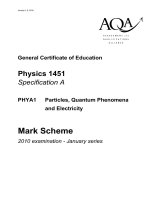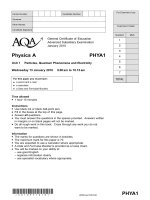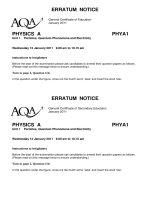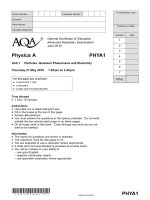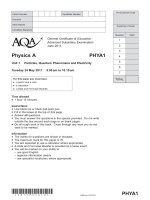- Trang chủ >>
- Khoa Học Tự Nhiên >>
- Vật lý
Vật lý A level: AQA PHYA5 2 b w QP JUN10
Bạn đang xem bản rút gọn của tài liệu. Xem và tải ngay bản đầy đủ của tài liệu tại đây (56.3 KB, 8 trang )
(JUN10PHYA52B01)
WMP/Jun10/PHYA5/2B
PHYA5/2B
Centre Number
Surname
Other Names
Candidate Signature
Candidate Number
General Certificate of Education
Advanced Level Examination
June 2010
Time allowed
●
The total time for both sections of this paper is 1 hour 45 minutes.
You are advised to spend approximately 50 minutes on this section.
Instructions
●
Use black ink or black ball-point pen.
●
Fill in the boxes at the top of this page.
●
Answer all questions.
●
You must answer the questions in the spaces provided. Do not write
outside the box around each page or on blank pages.
●
Do all rough work in this book. Cross through any work you do not
want to be marked.
Information
●
The marks for questions are shown in brackets.
●
The maximum mark for this section is 35.
●
You are expected to use a calculator where appropriate.
●
A Data and Formulae Booklet is provided as a loose insert.
●
You will be marked on your ability to:
– use good English
– organise information clearly
– use specialist vocabulary where appropriate.
For this paper you must have:
●
a calculator
●
a ruler
●
a Data and Formulae Booklet.
Physics A PHYA5/2B
Unit 5B Medical Physics
Section B
Tuesday 29 June 2010 1.30 pm to 3.15 pm
MarkQuestion
For Examiner’s Use
Examiner’s Initials
TOTAL
1
2
3
4
WMP/Jun10/PHYA5/2B
Do not write
outside the
box
Section B
The maximum mark for this section is 35 marks. You are advised to spend approximately
50 minutes on this section.
1 (a) Complete the ray diagram to show the formation of the image of a real object by a
diverging lens.
(2 marks)
1 (b) Define the power of a lens.
(1 mark)
(02)
2
object
F F
WMP/Jun10/PHYA5/2B
Tur n over
ᮣ
(03)
Do not write
outside the
box
1 (c) A lens of focal length – 0.56m is used to correct a defect of vision of an eye.
1 (c) (i) Name this defect of vision.
(1 mark)
1 (c) (ii) The defective eye has an unaided near point at 0.15 m from the eye.
Calculate the aided near point distance, giving your answer to an appropriate number of
significant figures.
answer = m
(3 marks)
1 (d) Another person was found to suffer from astigmatism. State the format of the
prescription to correct this defect.
(1 mark)
Turn over for the next question
3
8
WMP/Jun10/PHYA5/2B
Do not write
outside the
box
2 (a) (i) Describe how the vibrations of a sound wave are received by the outer ear and
transmitted to the inner ear.
(3 marks)
2 (a) (ii) Explain how the pressure changes due to the sound wave are amplified by the ear.
(2 marks)
2 (b) An intensity meter, set to the dB scale, measures the intensity level of a sound as 46 dB.
Calculate the intensity of the sound at the meter, giving an appropriate unit.
answer =
(3 marks)
4
(04)
WMP/Jun10/PHYA5/2B
Do not write
outside the
box
2 (c) The scale on the intensity meter is changed to the dBA scale and the new reading, for
the same sound, is found to be 50 dBA. Explain this change.
(2 marks)
Turn over for the next question
5
Tur n over
ᮣ
(05)
10
WMP/Jun10/PHYA5/2B
Do not write
outside the
box
3 (a) On the axes below, sketch the action potential of a nerve cell. Indicate units and scales
on both axes.
(3 marks)
3 (b) Explain in terms of ion movement, starting at resting potential, how bioelectrical signals
are produced in muscle fibres.
The quality of your written answer will be assessed in this question.
(7 marks)
6
(06)
10
action
potential /
. . . . . . . .
time
/
. . . . . . . .
WMP/Jun10/PHYA5/2B
(07)
Do not write
outside the
box
4 (a) Outline the basic principles of a magnetic resonance (MR) scanner used to scan a
patient’s brain.
(3 marks)
4 (b) State and explain two advantages of using an MR scanner to scan a patient’s brain
compared with a CT scanner.
(4 marks)
END OF QUESTIONS
7
7
WMP/Jun10/PHYA5/2B
(08)
Do not write
outside the
box
8
There are no questions printed on this page
DO NOT WRITE ON THIS PAGE
ANSWER IN THE SPACES PROVIDED
Copyright © 2010 AQA and its licensors. All rights reserved.

